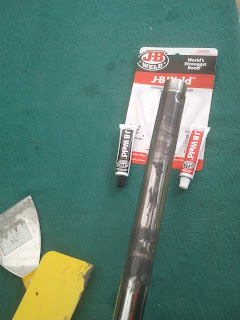When a two stroke engine hasn't been used for years you can be almost 100% sure the crankshaft oil seals are dried out and will start leaking when you gonna run the engine. If your bike has only minor air leaks and you don't red line your bike too often you can get away with it for a while and maybe don't even notice there's an air leak.
The seal on the flywheel side prevents air from getting into the combustion chamber. If the seal on this side goes bad, you’ll get air leaks. If it's a big leak, your idle will hang and/or the bike will rev erratic randomly. The bike will run lean, it's impossible to tune it and there's a real danger of melting a hole in your piston(s). When you remove the cover on this side and you see oil at the bottom, you can be sure it's leaking.
The seal on the clutch side prevents crankcase oil from getting into the combustion chamber. If the seal on this side is leaking the engine will suck oil into the combustion chamber. You get greasy spark plugs, high oil consumption, lots of smoke, etc...not good...
 |
| Leaking crankshaft oil seals two stroke engine |
As the engine was already out of the frame I started taking off the engine covers. Using an impact screwdriver will make the job a bit easier. Don't forget the long screw-bolt on the right (clutch) side which is hidden underneath the smaller oil pump cover. You can leave the oil pump inside the cover, just disconnect the tubes to the cylinder and oil tank.
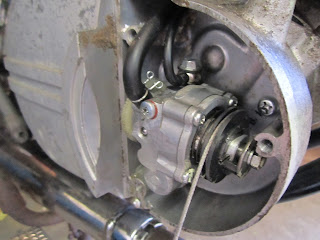 |
| Don't forget this bolt above the oil pump spindle |
 |
| Clutch cover inside with oil pump gear |
After taking off the engine covers I had to remove the flywheel/magneto and the clutch assembly. In order to loosen the clutch- and primary gear nut you need a special tool, a clutch holder, but even then it can be really hard. However there's a nice little trick to loosen those nuts in a couple of seconds. Take an air impact wrench, hold the clutch assembly firmly with your other hand (wear a glove, just in case..) and it will be loose in a second.
 |
| Clutch boss and gear and primary gear crankshaft |
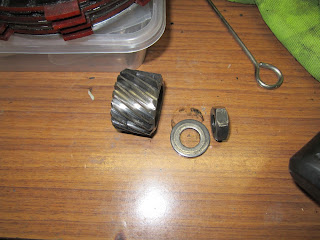 |
| Primary gear crankshaft Yamaha LS3 |
Same story on the other side with the nut that's holding the flywheel nut. But once the nut is off you really need a special tool, a flywheel puller. Now install the flywheel puller in the thread and use the air impact wrench again.
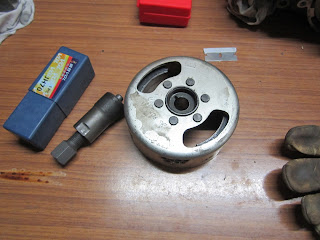 |
| Yamaha Flywheel puller and Flywheel Yamaha LS3 |
When the flywheel magneto is off the engine you can loosen the two screws that hold the timing plate with a impact screwdriver. This way there's less change you'll damage the two screws.
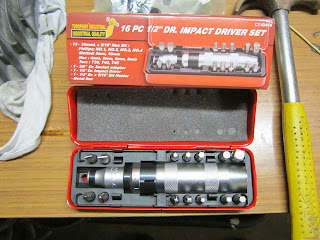 |
| Impact screwdriver set |
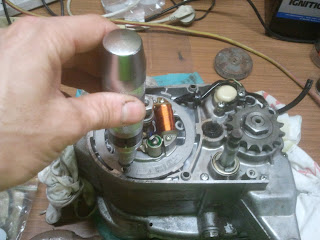 |
| Using the impact screwdriver to loosen some screws |
Finally I could reach and remove the old crankshaft oil seals. If you don't have a special seal remover tool you can also use a screw to remove the seals. The "problem" with the screw method can be that you scratch/damage the surrounding metal in which case you've created a permanent leak which can't be solved with a new oil seal. The oil seal on the flywheel side can out pretty easy without any collateral damage.
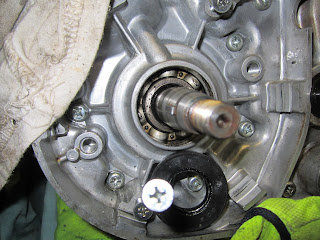 |
| First oil seal out |
However on the other side we have a different kind of oil seal; one with two lips. So it's a bit harder to put a screw in this seal. In my case it slipped a couple of times off of the seal and scratched the collar @#$^*!!
Luckily a new collar is only a couple of dollars so this issue was quickly resolved.
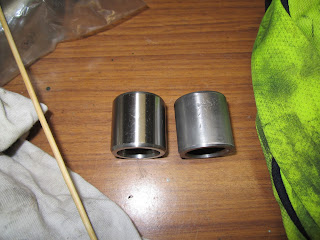 |
| Old and new collar crankshaft clutch side |
Underneath the collar is another oil seal which you have to replace, it's a simple tiny O-ring. With a wooden pick I could lift it and pull it off the crankshaft. The new O-ring was of course a bit thicker then the worn out old one so it was a bit harder to put the collar back onto the crankshaft. But with the help of the old collar it was easy as..
 |
| Removing the old crankshaft oil seal O-ring |
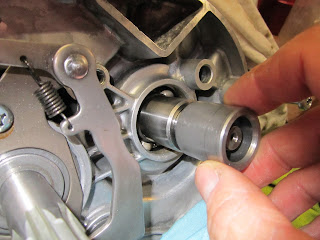 |
| Fitting the new collar over the new O-ring |
Next time (on my Yamaha RD125A) I'm gonna use a special oil seal remover tool which I got in the mail today :)
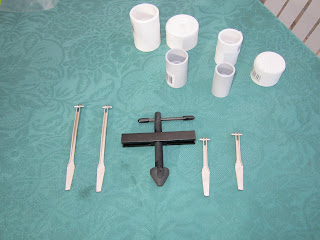 |
| Oil seal puller and installer set |
When fitting the new oil seals you have to fill the lips with grease and make sure they go in nice and even. I used a couple of pvc pipes to push 'm in. Make sure you're using a pipe with exactly the same outer diameter as the oil seal, otherwise you can easily damage the lips. Before I pushed them in I've put some oil on them to make things a bit easier.
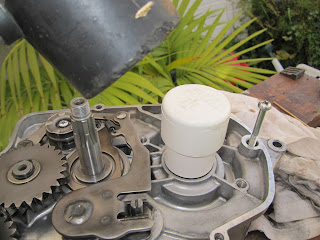 |
| Installing a new crankshaft oil seal |
With the new oil seals in place I had to put back the clutch assembly, primary gear and flywheel-magneto. This time no air wrench because those nuts need a specified torque: around 65 Nm for the primary gear and flywheel and around 55 Nm for the clutch assembly. But how do you stop those gears from turning. First I tried it with some rags between the primary gear and clutch gear, but the teeth were too sharp and the rags were simply eaten by the gears. Then I tried it with a 20 cent piece and it worked, however the coin is a bit damaged now ;)
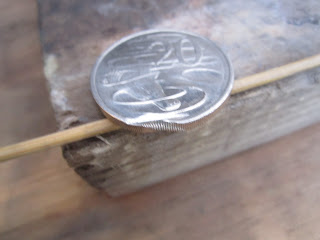 |
| Coin after use as "gear holder" |
Oww...before I put the nuts back on used a bit of 243 Loctite threadlocker on the primary gear and flywheel nut.
 |
| Loctite 243 "Threadlocker" |
Another thing I still needed was a clutch tool holder, but I couldn't find the right size on Internet so I made one myself. I used one of the metal clutch plates and attached a grinder spanner. It's a bit soft but it worked. Next time I will use 3-4 metal clutch plates together to make it a bit more solid.
 |
| Making a clutch holder tool |
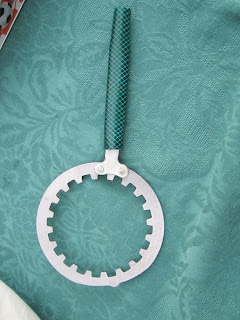 |
| Home made Yamaha Clutch holder tool |
Now I only have to buy me another clutch plate ;)



